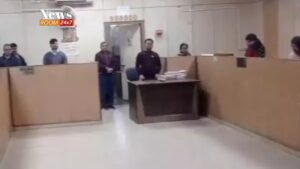Radiation, bone density issues, and anxiety: Sunita Williams’s new challenges in space

Two months after astronauts Sunita Williams and Butch Willmore arrived at the International Space Station, NASA announced that their return might be postponed until February 2025.
Originally, the NASA astronauts were scheduled to return within a week of their launch from Earth on June 5, 2024, aboard Boeing’s maiden human spaceflight with the Starliner.
NASA has now indicated that they may need to return to Earth on SpaceX’s Crew Dragon rather than their original spacecraft, Boeing’s Starliner.
This situation implies that Boeing’s inaugural human mission might require an extraordinary rescue operation by Elon Musk’s SpaceX, extending what was initially an eight-day mission to over eight months. Such an extended period in space raises concerns about the effects on the astronauts’ physical and mental health.
Radiation Exposure Is a Concern
While the ISS, a $150 billion orbiting laboratory, offers living facilities, sleeping quarters, and a gym, operating in an artificial environment away from Earth’s protective atmosphere remains inherently challenging.
Visitors to the International Space Station (ISS) orbit the planet at a height of roughly 400 kilometers. This implies that the magnetic field and atmosphere of Earth are no longer shielding them from dangerous solar radiation. In reality, the International Space Station (ISS) flies through an area close to South America’s eastern coast where radiation levels are approximately 30 times higher than on Earth.
Put another way, astronauts aboard the ISS endure radiation exposure equivalent to a year on Earth in just one week.
Astronauts are exposed to radiation at amounts between 50 to 20,000 millisieverts (mSv), to put this into perspective. The radiation measurement unit used is the millisievert. As a point of comparison, the radiation dose from three chest X-rays is approximately equal to 1 mSv.
In other words, astronauts are exposed to between 150 and 6,000 chest X-rays of radiation. This increased radiation exposure can cause cancer, degrade tissues, and harm the brain system, especially over an extended period of time.
Elevated radiation levels can harm lymphocytes, which are crucial for immune system maintenance. This damage leads to reduced immunity in astronauts, making them more susceptible to infections from existing microbes in their bodies.
EFFECT OF ZERO GRAVITY ON THE BODY
Extended periods spent in zero gravity, or microgravity, are the second main problem in space.
The gravitational pull of Earth is always there when we are here, and our bodies are always working to resist it. This exercise is eliminated by prolonged microgravity exposure, which can result in bone and muscle mass loss.
Approximately 1.5% of bone tissue can be lost per month, primarily from the hip, femur (upper leg), and lower vertebrae. This can slow down the cardiovascular system, lower aerobic capacity, raise the chance of injury, and degrade astronaut performance.
The majority of the fluids in the human body are forced into the lower half of the body by gravity. To maintain this equilibrium, our bodies employ a variety of systems. However, these counterbalancing mechanisms keep functioning when the body is freed from gravity, which results in a general redistribution of fluids into the upper body.
This is the cause of the ‘puffiness’ or round face that astronauts have. It could be a factor in reports of impaired speech, motor function, taste, smell, and balance loss among astronauts.
THE PSYCHOLOGICAL BALANCE
The third challenge, particularly relevant to the Boeing situation, is psychological. Imagine planning an eight-day trip away from your family only to find yourself stranded for a minimum of eight months.
Imagine being marooned 400 kilometers above Earth in an environment far more isolated than the most remote islands imaginable. To compound the problem, the spacecraft you arrived in is leaking helium and has unreliable thrusters.
This is the harsh reality facing the two stranded astronauts. Despite Sunita and Butch being seasoned astronauts and skilled US Navy pilots trained to handle unpredictable scenarios, even they may find such prolonged isolation mentally taxing.
There is hope.
However, there are reasons for optimism.
Firstly, NASA has several alternatives for rescuing astronauts if Boeing is unable to fix the Starliner. The American space agency has a fully operational Dragon spacecraft from SpaceX at its disposal and could potentially seek assistance from the Russian space agency, Roscosmos, for a rescue mission.
That said, this would require significant technical modifications and geopolitical negotiations, especially given the current low state of Russian-American relations.
This isn’t the first instance of an astronaut spending extended periods in space. Russian cosmonaut Valeri Polyakov spent 437 continuous days aboard the Soviet-era space station Mir. Upon his return to Earth, he opted to walk the short distance from the space capsule to his chair.
By doing this, he demonstrated that, after a protracted flight from Earth, humans might be physically competent to work on the surface of Mars.
In other news, Sunita Williams is currently traveling at a pace of 28,000 kmph around the planet. The principle of relativity takes effect at such high speeds, making time appear to pass slightly more slowly for her than it does for the rest of us.
When Sunita Williams eventually returns to Earth after eight months, she will be 0.01 seconds younger than someone born at the same time and date as her on Earth.”









